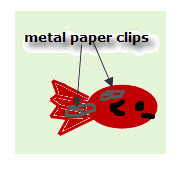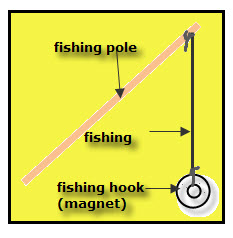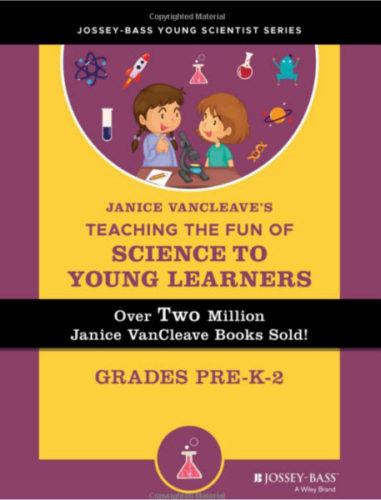I am a mom, grandmother, and great grandmother– In my spare time I wrote 52 science books for kids. Now I squeeze in time to write this science web site.
I also write articles for magazines. A parenting magazine asked me to provide them with fun activities for very young kids. At the time, my grandson, David, was 3 years old. So, I was able to try my ideas out on him. One activity that he loved was fishing. David caught “fish” every time he threw his “hook” in the “pond.”
Fish: The fish were cut from different colors of construction paper. Each fish had several small metal paper clips taped to each side. With laminating sheets purchased where office supplies are sold, I laminated each fish. This prevented the paper clips from being removed from the fish, which made it a safer activity for very young kids.
IDEA: Kids can help make the fish. The fish can be colored. Of course, you need to attach the paper clips and laminate the fish.
Fishing Pole: I experimented with a pencil and a dowel rod for the fishing pole. When using the pencil, which made a very short fishing pole, David could see the fish as well as his “hook” hitting the fish. But, David also had fun using the long pole.
Hook: The hook was a disk-shaped magnet with a hole in its center.
Fishing Line: Any type of string, such as crochet thread and kite string, works well for the fishing line.
Pond: Use any kind of container large enough to hold the paper fish.
Instead of a bucket or tub, use a box. The box could be decorated.
FYI: Since David was the fisherman, I was his helper–the one who removed the fish from the “hook.” With a little acting on my part, the fish wiggled and squirmed and some fell out of my hands back into the bucket.
I hope you have as much “fishing” with your young learners as I did with David.
Including Older Kids:
While this was a fun playtime activity for my 3 year old grandson, I have adapted it for older kids, such as fishing for questions on papers with paper clips attached. Or, just checking out what they can catch with their magnet hook indoors as well as outdoor. Some catches, such as the refrigerator are too big to be pulled in and break away from the hook.
Caution: Magnets should not be around some electrical devices, such as computers and TVs. Magnets can erase material on VCR tapes.
“Teaching the Fun of Science to Young Learners.”
This book focuses on process skills that form the foundation for scientific inquiry. It has the most comprehensive and sequential presentation of the scientific method of all my books. Fun science activities and investigations can be found on most web sites. My task was to use such ideas to first lay a science foundation, then start adding structure. The book is designed for teachers and/or parents. Each chapter addresses a specific process skill, such as investigating, observing, and measuring. There are teacher tips to assist in presenting the science skills and concepts as well as clues about each activity and investigation in the chapter. The student pages are designed to be written on and can be copied.
The book is designed to help young students catch the “science bug”
Teaching the Fun of Science to Young Learners
The book’s 75 lessons and reproducible activities touch on all areas of science and provide the key to a world of science magic and mystery. While kids will have fun doing the activities and learning to love science, they are also being encouraged to develop other skills, including reading, writing, math, and art.
(Paid Link)


